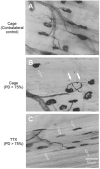Tetrodotoxin prevents motor unit enlargement after partial denervation in rat hindlimb muscles
- PMID: 12205197
- PMCID: PMC2290525
- DOI: 10.1113/jphysiol.2001.012982
Tetrodotoxin prevents motor unit enlargement after partial denervation in rat hindlimb muscles
Abstract
Findings that increased neuromuscular activity significantly reduced sprouting in partially denervated muscles prompted this present study to determine if the converse is true, namely that reduced activity promotes sprouting and motor unit (MU) enlargement. Partial denervation of rat hindlimb muscles by either the L4 or L5 spinal root avulsion resulted in extensive denervation (> 80 %) in tibialis anterior (TA) and medial gastrocnemius (MG) muscles, and moderate denervation (~50 %) in soleus (SOL) and plantaris (PL) muscles. The partially denervated muscles were then subjected to a 4 week programme of normal caged activity or TTX-induced neuromuscular inactivity. At 1 month, measurement of MU enlargement and quantification of sprouting were evaluated, respectively, by electrophysiological and histochemical means. Analysis of electrophysiological data showed that MU forces were significantly increased in both extensively and moderately denervated muscles 1 month after partial denervation and normal cage activity and that neuromuscular activity blockade by TTX completely abolished the MU enlargement in these partially denervated muscles. Histochemical analysis of sprouting revealed that the number of sprouts was significantly increased after partial denervation and normal cage activity, particularly after extensive denervation. TTX-induced neuromuscular inactivity dramatically reduced the number of sprouts and increased the number of free endplates in the extensively but not the moderately denervated muscles. These data demonstrate that a reduction in neuromuscular activity mediated by presynaptic blockade of neural action potentials reduces MU enlargement in partially denervated muscles by reducing axonal sprouting.
Figures




 ; n = 7 for PD < 75 % and n = 5 for PD>75 %). The dotted horizontal lines denote the
; n = 7 for PD < 75 % and n = 5 for PD>75 %). The dotted horizontal lines denote the 
Similar articles
-
Increased neuromuscular activity reduces sprouting in partially denervated muscles.J Neurosci. 2001 Jan 15;21(2):654-67. doi: 10.1523/JNEUROSCI.21-02-00654.2001. J Neurosci. 2001. PMID: 11160444 Free PMC article.
-
Neuromuscular activity impairs axonal sprouting in partially denervated muscles by inhibiting bridge formation of perisynaptic Schwann cells.J Neurobiol. 2003 Nov;57(2):221-34. doi: 10.1002/neu.10276. J Neurobiol. 2003. PMID: 14556287
-
Proportional enlargement of motor units after partial denervation of cat triceps surae muscles.J Neurophysiol. 1992 Oct;68(4):1261-76. doi: 10.1152/jn.1992.68.4.1261. J Neurophysiol. 1992. PMID: 1432083
-
Functional reorganization of the partially denervated hindlimb extensor and flexor muscle in rat.Acta Neurobiol Exp (Wars). 1996;56(1):441-7. doi: 10.55782/ane-1996-1147. Acta Neurobiol Exp (Wars). 1996. PMID: 8787205 Review.
-
[Mechanisms controlling axonal sprouting at the neuromuscular junction].Neurochirurgie. 2009 Mar;55 Suppl 1:S63-8. doi: 10.1016/j.neuchi.2008.05.005. Epub 2009 Feb 14. Neurochirurgie. 2009. PMID: 19223046 Review. French.
Cited by
-
The basis for diminished functional recovery after delayed peripheral nerve repair.J Neurosci. 2011 Apr 6;31(14):5325-34. doi: 10.1523/JNEUROSCI.6156-10.2011. J Neurosci. 2011. PMID: 21471367 Free PMC article.
-
Optically-Induced Neuronal Activity Is Sufficient to Promote Functional Motor Axon Regeneration In Vivo.PLoS One. 2016 May 6;11(5):e0154243. doi: 10.1371/journal.pone.0154243. eCollection 2016. PLoS One. 2016. PMID: 27152611 Free PMC article.
-
Sprouting capacity of lumbar motoneurons in normal and hemisected spinal cords of the rat.J Physiol. 2010 Aug 1;588(Pt 15):2745-68. doi: 10.1113/jphysiol.2010.190389. Epub 2010 Jun 2. J Physiol. 2010. PMID: 20519315 Free PMC article.
-
Presynaptic NCAM is required for motor neurons to functionally expand their peripheral field of innervation in partially denervated muscles.J Neurosci. 2014 Aug 6;34(32):10497-510. doi: 10.1523/JNEUROSCI.0697-14.2014. J Neurosci. 2014. PMID: 25100585 Free PMC article.
References
-
- Brown MC, Holland RL. A central role for denervated tissues in causing nerve sprouting. Nature. 1979;282:724–726. - PubMed
-
- Brown MC, Holland RL, Hopkins WG, Keynes RJ. An assessment of the spread of the signal for terminal sprouting within and between muscles. Brain Research. 1980;210:145–151. - PubMed
-
- Brown MC, Holland RL, Hopkins WG. Motor nerve sprouting. Annual Review of Neuroscience. 1981;4:17–42. - PubMed
-
- Brown MC, Holland RL, Ironton R. Is the stimulus for motoneurone terminal sprouting localized? Journal of Physiology. 1978;282:7–8P. - PubMed
-
- Brown MC, Ironton R. Motor neurone sprouting induced by prolonged tetrodotoxin block of nerve action potential. Nature. 1977;265:459–461. - PubMed
Publication types
MeSH terms
Substances
LinkOut - more resources
Full Text Sources
Research Materials

